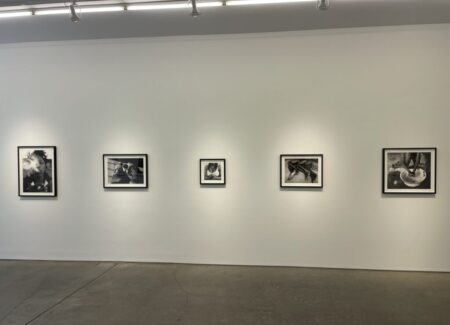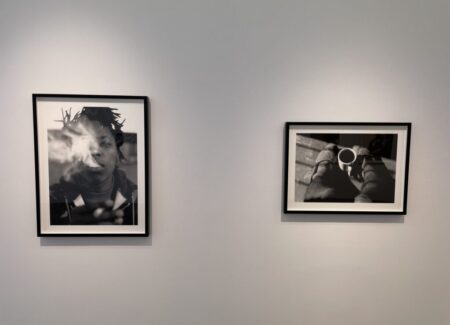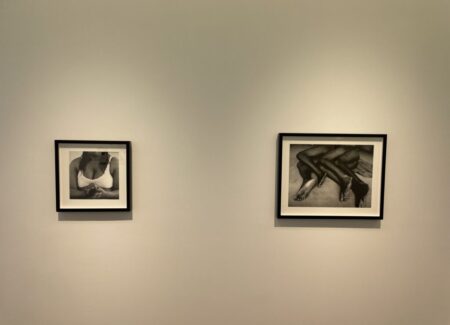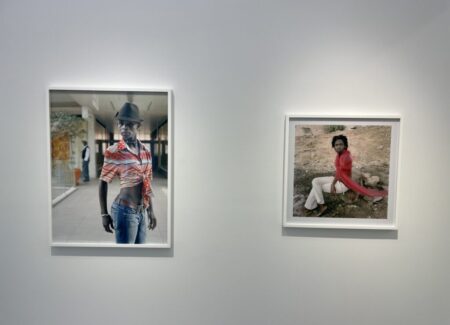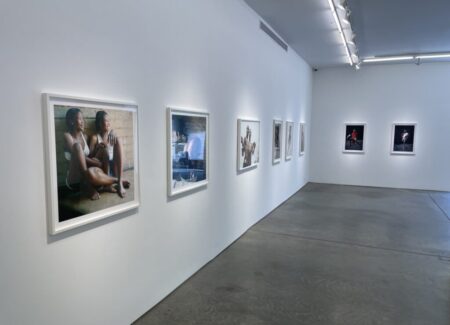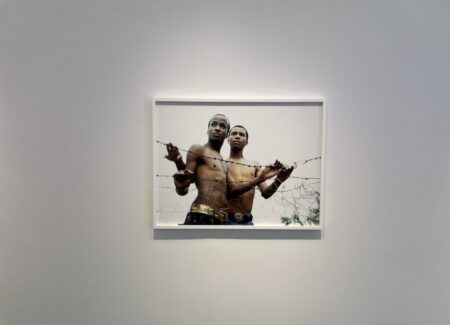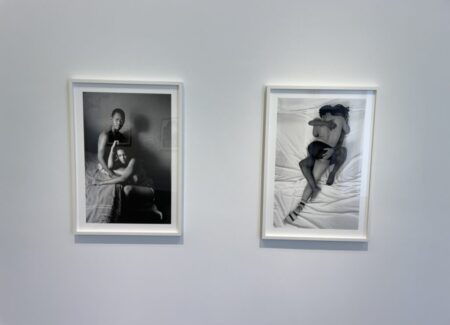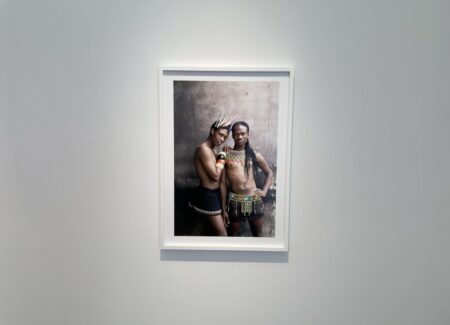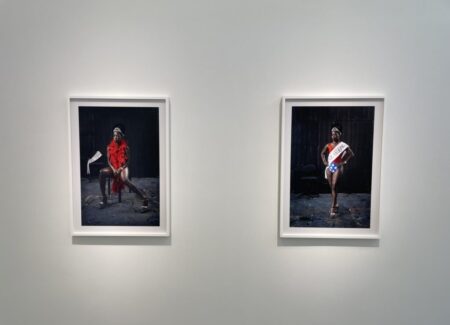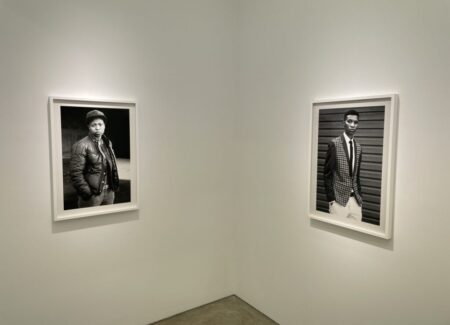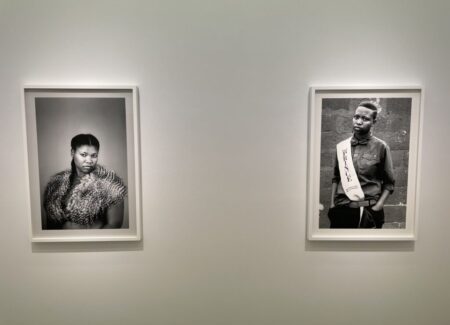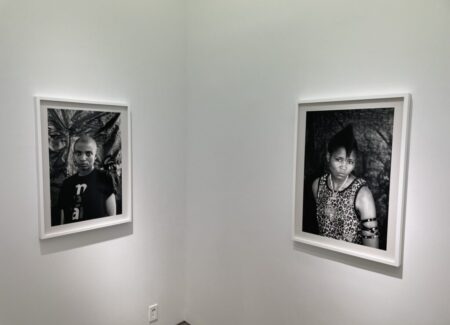JTF (just the facts): A total of 22 black-and-white and color photographs, variously framed and matted, and hung against white walls in the main gallery space and the smaller project gallery. (Installation shots below.)
The following works are included in the show:
- 5 gelatin silver prints (from the series “Only Half the Picture”), 2002, 2003, 2005, sized roughly 33×25, 26×29, 22×29, 20×25, 16×16 inches, in editions of 8
- 4 archival pigment prints (from the series “Beulahs”), 2006, 2010, sized roughly 41×31, 31×41, 35×25, 29×29 inches, in editions of 8
- 2 archival pigment prints (from the series “Being”), 2007, sized roughly 35×35 inches, in editions of 8
- 2 gelatin silver prints (from the series “Being”), 2007, 2009, sized roughly 36×25 inches, in editions of 8
- 2 archival pigment prints (from the series “Miss Lesbian”), 2009, sized roughly 35×25 inches, in editions of 8
- 7 gelatin silver prints (from the series “Faces and Phases”), 2012, 2013, 2024, sized roughly 35×25 inches, in editions of 8
Comments/Context: Largely on the basis of an extended run of indelibly original self-portraiture in the past decade, Zanele Muholi has cemented their position on the short list of mid-career photographers who are defining early 21st century photography. At this point, it’s hard to visit an art fair here in New York (or elsewhere for that matter) or to scan the exhibition list of any number of global museums without encountering Muholi’s work, which says something about the breadth of both their current appeal (Muholi uses they as a pronoun) and their ongoing cultural relevance.
But of course, it wasn’t always this way. We first encountered Muholi’s work back in 2012, and soon followed that up with a review of their 2013 “Faces and Phases” gallery show (reviewed here). It wasn’t long after (in 2015) that Muholi landed an early career survey at the Brooklyn Museum (reviewed here), which gave them some much needed New York institutional support and helped to broaden their audience. It would, of course, be overly easy to say that the rest is history, but Muholi’s artistic momentum in recent years has felt altogether formidable.
This show rewinds all the way back to the beginning of Muholi’s career, sampling their various photographic projects from the early 2000s up through the initial years of the long term “Faces and Phases” effort. In examining this first decade of their photographic career with the benefit of hindsight, we can watch as Muholi tries out different portraiture strategies for capturing the black queer experience in South Africa, in a sense experimenting with ways to balance struggle and trauma with more positive affirmations of personal joy and dignity.
“Only Half the Picture” was Muholi’s first project, and documents survivors of hate crimes across South Africa (via an organization the artist co-founded in 2002.) The black-and-white images get in close, to isolated fragments of legs, arms, torsos, and faces at rest, redirecting the narrative of violence and suffering into something more calm and intimate. In this way, a puff of smoke, the dark stubble of body hair, and gently nested legs become understated symbols of personal resilience and perseverance.
Muholi’s “Beulahs” project (begun in 2006) features a series of outdoor portraits of gay men, the term “beulah” applied to those deemed particular beautiful by the queer community. Working in color, Muholi accents the confident glamour of a sweep of tulle, a shirt tied like a halter top, the combination of bare chests and sparkling belt buckles, and more elaborate adornments of beads and plastic combs. The resulting portraits are exercises in careful self-presentation, with the usual definitions of masculinity glamorously extended.
Made roughly concurrently (or at least overlapping) with “Beulahs”, the “Being” project challenges the negative stereotypes applied to queer couples, focusing on the loving bonds between a range of pairs. In double portraits, Muholi centers in on tender gestures and intimate closeness, including moments of quietly sitting together with arms and legs entangled, washing together in a basin, and resting together in a close embrace. These images (in both black-and-white and color) are consistently warm and comfortable, with gentle touch and casual everyday closeness repeatedly on view.
Muholi gets a bit more conceptual in their “Miss Lesbian” self-portraits from 2009. Casting herself as a beauty pageant winner, complete with tiara, sash, feathered boa, and Wonder Woman bodysuit, Muholi actively wrestles with (and satirizes) the constraints of gender and appearance. More than some of their other early projects, these works prefigure the artist’s later (and broader) interest in photographic self-portraiture, using her own body as canvas for expressive experimentation with identity.
In a certain way, pieces and ideas from all of these early projects ultimately make their way into “Faces and Phases”, the powerhouse project that put Muholi on the art world map. A small selection of these black-and-white portraits are on view in the smaller side gallery, both from a decade ago and more recently, as the expansive effort to document the lives of black LGBTQ people in South Africa is ongoing. Using a generally consistent upper torso/vertical framing convention, the collaborative images have become a taxonomy of individuality within the community (and an ever expanding visual archive), with conventions of masculinity and femininity constantly remixed as the sitters go through their own changes. Part of what makes these portraits so consistently powerful is the directness of the exchange taking place – looking straight into the lens, every one of these sitters is actively being seen, the conflicted confidence and vulnerability of that process readily on view. And it is this blunt, unwavering engagement with the camera that then brings us full circle (as a precursor) to Muholi’s more recent self portraits.
Seen together, this tightly edited sampler show provides a thoughtful summary of Muholi’s early projects, offering much needed historical and aesthetic context for their current rise in the art world. Clearly, it’s been a step-wise journey over time, with learnings slowly aggregated and confidence slowly built. But for those who want to connect the dots from past to present, this smart show ably delivers the missing pieces.
Collector’s POV: The prints in this show are priced between $7500 and $21000, based on size, with some already sold. In the past five years, Muholi’s work has become much more available in the secondary markets, with recent prices ranging from roughly $6000 to $40000.
